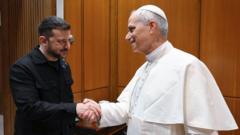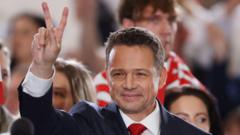In an atmosphere steeped in tradition, 133 cardinals entered the Sistine Chapel on May 7, 2025, marking the commencement of a papal conclave aimed at selecting the next leader of the Roman Catholic Church. This congregation, the largest number of voting cardinals in history, reflects both potential and division within the church. Following the death of Pope Francis, the cardinals are tasked with addressing pressing issues such as direction, financial constraints, and ongoing trauma from past sex abuse scandals.
The Papal Conclave Begins: Cardinals Seclude to Elect Pope

The Papal Conclave Begins: Cardinals Seclude to Elect Pope
Cardinals gather in the Sistine Chapel amidst rituals and controversy, setting the stage for the election of a successor to Pope Francis.
Before entering seclusion to vote, the cardinals partook in a mass at St. Peter’s Basilica, a customary preparation for such a profound responsibility. According to tradition, they will be isolated from the outside world without access to phones or the internet until a decision is reached. An initial vote was expected, but a two-thirds majority is often challenging, necessitating multiple rounds of voting.
This conclave carries a unique dimension as many cardinals appointed by Francis are participating for the first time, leading to a likely shift in dynamics and priorities. Speculation surrounds possible successors, with Cardinal Pietro Parolin of Italy and Cardinal Luis Antonio Tagle of the Philippines emerging as leading contenders. However, opinions are divided; progressive factions support inclusion and change, while conservative cardinals are pushing back and seeking to maintain traditional values.
Should the cardinals fail to elect a new pope on the first day, they will continue voting daily until a consensus is reached. The outcome will not only affect the future direction of the Catholic Church but may also signify a referendum on the legacy left behind by Pope Francis, whose tenure was marked by significant outreach efforts and progressive reforms.
Each key moment within the chapel under Michelangelo's masterworks will be pivotal as the waiting begins for the definitive result, with Vatican City temporarily transforming into a sanctum for this sacred yet contentious endeavor.
This conclave carries a unique dimension as many cardinals appointed by Francis are participating for the first time, leading to a likely shift in dynamics and priorities. Speculation surrounds possible successors, with Cardinal Pietro Parolin of Italy and Cardinal Luis Antonio Tagle of the Philippines emerging as leading contenders. However, opinions are divided; progressive factions support inclusion and change, while conservative cardinals are pushing back and seeking to maintain traditional values.
Should the cardinals fail to elect a new pope on the first day, they will continue voting daily until a consensus is reached. The outcome will not only affect the future direction of the Catholic Church but may also signify a referendum on the legacy left behind by Pope Francis, whose tenure was marked by significant outreach efforts and progressive reforms.
Each key moment within the chapel under Michelangelo's masterworks will be pivotal as the waiting begins for the definitive result, with Vatican City temporarily transforming into a sanctum for this sacred yet contentious endeavor.




















